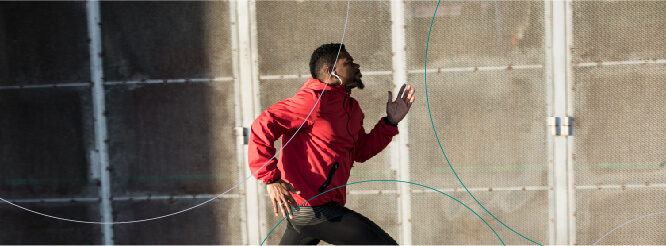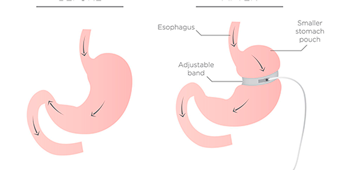
The gastric sleeve, also known as sleeve gastrectomy, is one of the most effective and safe ways of losing weight if you are struggling from obesity. A gastric sleeve is a bariatric and laparoscopic procedure in which the stomach is divided with surgical staples, extracting roughly 80% of its size. The new stomach is in this way reduced to nearly 20% of its original size, allowing the patient to eat much less. Patients can experience less appetite and faster satiety when eating, thanks to a reduction in the production of the hunger hormone known as ghrelin, which is a convenient by-product of this procedure.
The laparoscopic techniques used in this procedure make the gastric sleeve a non-invasive surgery that lasts an average of 50 minutes. The patient is then held under observation for one day, and can then head home for a recovery period that lasts a couple of weeks. As for any type of surgery, proper recovery is very important for the treatments’ success and safety. The patient who underwent a gastric sleeve must rest for four to six weeks after the surgery. During these weeks, the patient should not lift heavy objects, walk through heavy sets of stairs nor engage in demanding exercises. This will allow the staple line in the stomach to heal properly. However, this doesn’t mean that the patient should be under bed rest for those four to six weeks nor that she or he should avoid any physical activity.
Start by walking
Walking is one of the convenient and accessible forms of exercise. A patient who underwent gastric sleeve surgery should start recovering her or his mobility after the first week after surgery by doing short low-impact walks throughout the day. You can move around the house, go grocery shopping or give slow, short walks around your block. These walks can boost your circulation, energize your body, and strengthen your physical condition.
Walking is also the perfect transitional activity for more demanding exercise routines later, after your recovery phase. During your second, third, and fourth weeks of recovery, you can gradually increase the pace, distance and duration of your walks for a more invigorating workout.
And when can I start running?
This will depend on your recovery and on the advice of your surgeon. However, most patients can start running and exercising one month after their surgery. Running is considered a vigorous-intensity activity, because it requires a high level of energy expenditure, greater than 6 METs (Metabolic Equivalent of Task). Sitting quietly is equivalent to the expenditure of only 1 MET [1].
According to the World Health Organization, adults should engage in at least 75 to 150 minutes of vigorous-intensity aerobic physical activities per week as a healthy habit [2]. This means that exercising or running for 30 minutes a day, 5 days a week, accomplishes that goal.
Common guidelines issued by the ASMBS, the Obesity Society, and the American Association of Clinical Endocrinologists recommend that postoperative patients should adhere to a healthful lifestyle including exercising for at least 30 minutes per day [3].
If you’re having trouble running for 30 minutes a day, don’t despair. Patients who underwent gastric sleeve surgery should increase their physical activity gradually. You can start by running only 10 minutes, making increases of 5 more minutes little by little. You can also start by running at a low speed, until you are feeling comfortable running at a steady pace for 30 minutes, and then increase your speed gradually in the following weeks.
Exercise is key after gastric sleeve surgery
Exercising (either by walking, running, swimming, or any other exercise, for that matter), along with a balanced diet, are key measures that guarantee that the outcomes of the gastric sleeve surgery will be long lasting. The gastric sleeve surgery achieves great weight loss in a very short period of time, but this is not accomplished with the surgery by itself. To obtain long lasting results, and to avoid any weight regain, patients who underwent bariatric surgery should also adopt healthy lifestyle habits, such as having a balanced diet, and, of course, practicing moderate exercise frequently, at least thrice a week.
Sustaining an exercise routine will guarantee the best possible results for your surgery; at the same time, it will improve your quality of life. Exercising improves your physical condition, it lowers the risk of developing heart conditions, diabetes and certain types of cancer, and it also boosts your mental health and self-esteem.
Contact us
At LIMARP International Center of Excellence for obesity, located in Tijuana, Mexico we offer an integral bariatric program that treats obesity from a multidisciplinary approach. We provide either surgical or non-surgical interventions such as the gastric sleeve, gastric bypass, mini-gastric bypass, duodenal switch, intragastric balloon and gastric clip, along with nutritional guidance, psychological counselling and fitness coaching that includes a personalized fitness routine that adapts to your needs for every phase of your treatment.
If you’re interested in knowing more about exercising after bariatric surgery or if you’re interested in getting to know more about our available treatments for obesity, please give us a call or send us a message through this webpage or any of our social media sites. You could schedule a free consultation today.
References
[1] Physical Activity Guidelines Advisory Committee, “2018 Physical Activity Guidelines Advisory Committee Scientific Report,” U.S. Department of Health and Human Services, Washington, D. C., 2018. [Online]. Available: https://health.gov/sites/default/files/2019-09/PAG_Advisory_Committee_Report.pdf
[2] “Physical activity,” World Health Organization, Nov. 26, 2020. https://www.who.int/news-room/fact-sheets/detail/physical-activity (accessed Sep. 30, 2021).
[3] P. M. Coen, E. A. Carnero, and B. H. Goodpaster, “Exercise and Bariatric Surgery: An Effective Therapeutic Strategy,” Exerc. Sport Sci. Rev., vol. 46, no. 4, pp. 262–270, Oct. 2018, doi: 10.1249/JES.0000000000000168.


